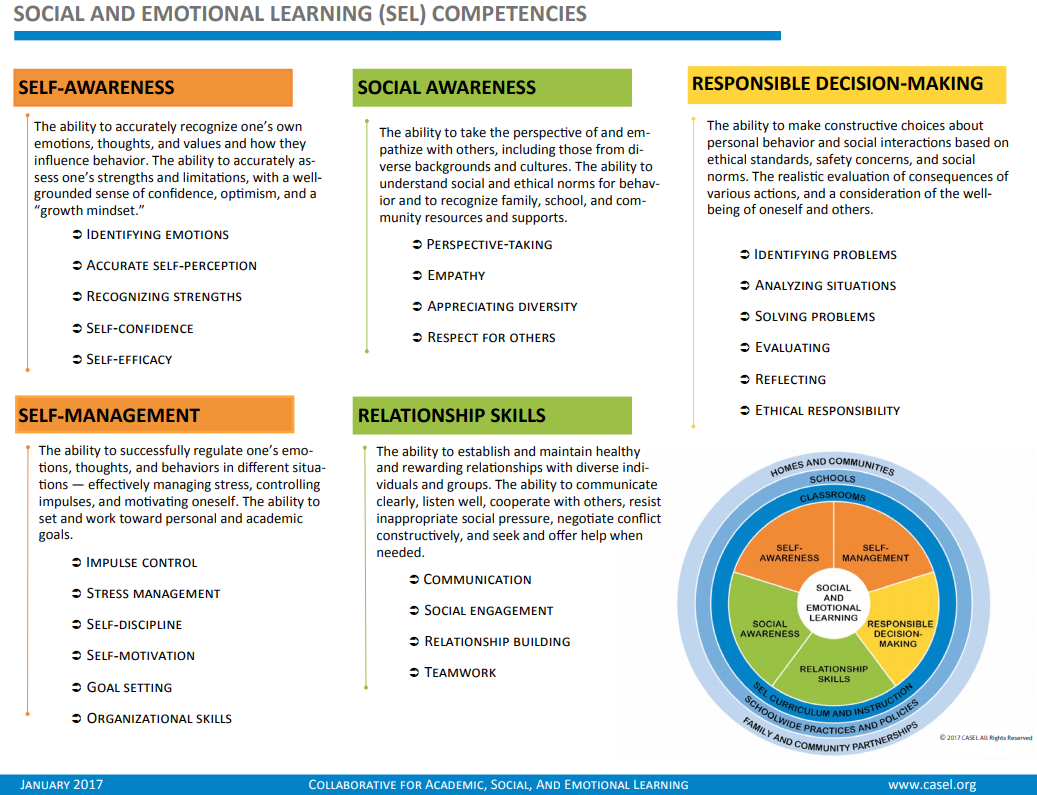Social and emotional learning
Skills of the future aren’t limited to just science, technology, engineering, and math (STEM). Social and emotional skills are quickly taking center stage alongside cognitive skills, technical skills, and content knowledge in both the class and the workforce. For your learners, social and emotional skills development is an integral part of learning, shaped largely by the experiences provided to them in the class and through remote learning.
The class of 2030 research shows that social and emotional skill development is two times more predictive of a learner’s academic achievement than their home environment or demographic and has the potential to increase academic performance by 11%. Social and emotional skills provide learners with the perspective and flexibility necessary to function at a high level even when faced with uncertainty, change, pressure, stress, and other challenges.
The five core competencies of SEL as defined by CASEL are:
- Self-awareness
- Self-management
- Social awareness
- Relationship skills
- Responsible decision-making

Link to text version of CASEL social and emotional learning (SEL) competencies
Reflection: SEL skills
Review this list of skills. How do you rank these skills from most to least important for learners?
- Literacy
- Critical thinking
- Numeracy
- Social awareness
- Communication
- Self-awareness
- Collaboration
- Responsible decision-making
- Problem solving
- Civic literacy
- Agency
- Self-management
- Ethical understanding
- Intercultural understanding
- Relationship skills
- Creativity
- Digital skills
Look at the skills at the top of your list. Why do you consider these skills the most important? Which skills do you think your learners rank as being most important to them?
Learners care about social and emotional learning, and often prioritize these skills in their top five for their own education. When asked, learners participating in The class of 2030 and life-ready learning research study made clear that they value social and emotional skills development over cognitive skills development when they think about their futures. Knowing this, educators must alter perceptions of how these skills are addressed through teaching and learning and which skills are important to learners.
The types of skills that SEL supports—problem-solving and collaboration, for example—are integral for learners in developing life-ready competencies. In most schools, SEL is largely integrated into learning in two ways: "caught" and "taught" curriculum. Learners develop some amount of social emotional skills incidentally through environmental influences and interactions with educators and peers (“caught” curriculum). However, you can act proactively to develop and apply these skills at scale and depth through teaching and learning (“taught” curriculum).
What overt learning experiences provide learners opportunities to engage in “taught” social and emotional learning?
Explore it
Now it’s time to explore SEL in more depth. Use these interactive activities to gain more understanding of the five CASEL competencies and their associated skills, and easy ways to incorporate them as “taught” curriculum.
Explore SEL is an online resource that allows educators to navigate domains and skills associated with social and emotional learning while comparing different learning and education frameworks.
Various frameworks refer to similar skills with different names, or call different skills by the same name, making it hard to understand how these frameworks support each other. Use this online tool to help visualize frameworks, side-by-side, and the skills they champion. The data visualization shows where these skills overlap, intersect, and support each other.
Begin by exploring the CASEL framework in more depth and then select another framework for comparison.
- Go to the CASEL framework on Explore SEL. Explore the framework and the five SEL competencies.
- Continue exploring by comparing the CASEL framework for SEL and another framework such as 21st century skills.
- Explore and dive deeper into where skills overlap, intersect, and support each other.
Consider how these skills are used in these frameworks to design more opportunities to intentionally embed SEL as “taught” curriculum.
Another way to intentionally incorporate SEL skills is through mindfulness practices. Mindfulness is practiced as a group or independently, face-to-face, or even remotely. Microsoft leader Mark Sparvell offers tips for practicing mindfulness with your learners in the video. What small steps create more opportunities for learners to develop SEL skills?
Alignment with SEL competencies
Before reflecting and moving on to the next unit, preview the Microsoft tools and their alignment with CASEL’s five SEL competencies. While these tools support all five CASEL competencies in various ways, this unit highlights two specific competencies for each tool.
Reflect
Review takeaways and learnings about SEL. Go back over your module graphic organizer and note any ideas for implementation and resources.
Reflect on these questions:
- What curricula, support services, and strategies do you already employ to support SEL skills development?
- How do efforts to support SEL better align with your learners’ needs?